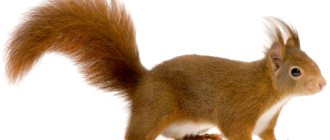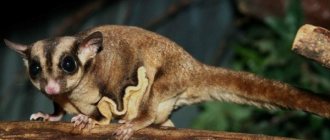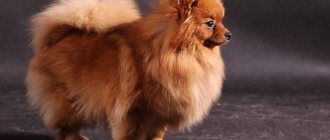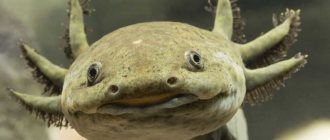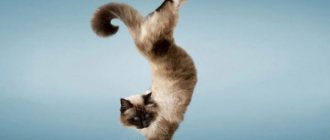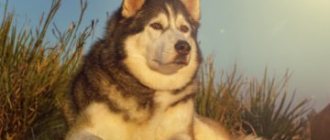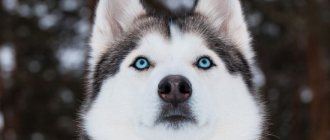Description of the flying squirrel
The animal belongs to the Marsupial family. It differs from other representatives by the presence of wide leathery plates between the front and hind legs. Thanks to them, the animal is able to soar in the air and cover distances of up to 60 m. If necessary, squirrels change their flight path so as not to collide, for example, with tree branches.
Adult sizes range from 17-21 cm in length. At the same time, males are slightly larger than females. In terms of size, flying squirrels are inferior to ordinary squirrels. The weight of an adult animal rarely exceeds 170 g. The animals have gained popularity among breeders due to the fact that they adapt well to home conditions. The lifespan of flying squirrels with good care is 15-17 years, and their price varies from $35 to 200.
What does a flying squirrel look like?
It is difficult to distinguish a flying rodent from an ordinary one at first glance. They also have a bushy tail and uniform fur coloring. However, there are a number of features, in addition to dimensions, by which the sugar possum can be differentiated:
- the presence of a leathery fold on the side;
- huge eyes, thanks to which the animal is well oriented in space during the day and night;
- thick coat.
The animal has sharp claws on its paws, just like ordinary squirrels. They are designed to help the rodent move deftly through trees. The flying squirrel changes fur color depending on the time of year. In summer they turn red, and in winter they turn gray-beige. Such changes are necessary for animals to camouflage. This way they blend better with the outside environment and become invisible to predators.
Number
The number of flying squirrels is small, hunting for it is limited. Fur is of little value. Despite the beauty and softness of the fur, it has a very thin and fragile inner core, which makes it difficult to use. It was believed that the flying squirrel does not take root well in captivity, but V.M. Smirin at the Zvenigorod biological station of Moscow State University kept flying squirrels of two subspecies in small enclosures for many years.
Fossil remains of the common flying squirrel (Pretomys volans) are known only from the end of the Late Pleistocene, although the remains of other species of the flying squirrel family (Pteromyidae) first appear from the Miocene, and the family flourished in the Miocene-Pliocene.
The species is listed in the Red Books of some regions.
Where does the flying squirrel live?
Animals live on the Australian continent, in Russia and Japan. They settle in dense forests. Tree hollows or abandoned bird nests are chosen as homes. Flying squirrels lead an active social lifestyle. They are not afraid of the close presence of people near their home. For this reason, they can be found in recreational parks, squares and cemeteries. Domestic flying squirrels can live in birdhouses. They will be happy to feast on what a person gives. At the same time, they can change their place of residence to a grove or a nearby forest plantation if the furnished home does not seem safe enough to them.
Soft bag
Fabric carriers have been around for a long time, but their modern development has primarily affected the increase in the number of all kinds of windows, mesh and other little things. The cat will no longer sit in a dark bag, not much different from an ordinary travel bag. It is difficult to organize a comfortable long trip in such a device. But for short distances the convenience is quite adequate.
The advantage of a soft cage is its lightness, compactness, and the ability to securely attach it to a car seat or, for example, to the handle of a suitcase.
Negatives: Not hygienic for long trips and difficult to clean quickly (although they can withstand washing in a regular washing machine).
Cost – 1,360 – 1,489 rubles.
How does a flying squirrel fly?
Before jumping, the animals climb to the highest point of a tree or human-organized dwelling. After this, they push and straighten the subcutaneous membranes. The wind helps the animal move forward, but flying squirrels can plan their flight path themselves. They are able to make 90° turns to the right and left and avoid obstacles. The common flying squirrel in flight resembles a trapezoid in shape.
A powerful fluffy tail helps the rodent control its movements. After landing on the end point, the squirrel grabs the trunk with its front and hind limbs and assumes a vertical position. Such movement in space saves the small animal from birds. Its camouflage color makes it invisible among tree crowns to other animals and humans.
Taming and making contact
Older individuals adapt less well to new living conditions and may show aggression or, conversely, be overly apathetic. It’s bad when the squirrel doesn’t make contact or refuses to eat.
But, as a rule, most often this does not happen, and the big-eyed animals show curiosity towards the new owner. To make friends with a baby squirrel and establish friendly contact, you can hand feed it. These little animals are very voracious and will not refuse a treat.
In this way, you can gradually tame him, and then achieve affection and the fact that he begins to recognize his owner.
Flying squirrel - species
There are 10 types of flying squirrels living in nature. Of these, only 7 live in Russia. They differ in their habitat and external features. The most popular species that are bred at home:
- Siberian
. Continues to stay awake in the winter and feed on reserves made in the summer. The number of animals is declining due to the fact that not all of them survive severe frosts. - Japanese
flying squirrel. Lives in evergreen coniferous forests. The squirrel insulates its nests with moss and lichen. - Australian
or sugar flying squirrel. Lives in regions with warm climates. The number of animals is declining due to poaching, so organizations have been created to save flying squirrels from illegal extermination.
Features of reproduction
The reproductive characteristics of these animals are currently the object of close attention from many scientists studying the animal world. It is known that the mating season of flying squirrels begins in mid-spring. The duration of pregnancy is about a month. In one litter, the female usually brings no more than four cubs.
The cubs are born blind with no fur, and begin to see only at two weeks of age. During the first month of life, they gain strength from their mother's milk. She stays near them most of the day, since the baby squirrels can freeze due to the lack of warm fur. When squirrels are about two months old, they completely switch to an adult diet. In mid-summer, young offspring master the basics of the art of flight and independent living skills, after which they leave their parents’ nests
Flying squirrel - keeping at home
It is possible to raise animals in a residential area if the area of the rooms allows. Flying squirrels need a lot of space to lead an active lifestyle: running, jumping and stocking up. There are several options for keeping a rodent:
- In a cage measuring at least 1 m³ with evening walks under the supervision of the owner. You cannot leave an animal unattended. It may cause a mess or eat a forbidden treat.
- In a large enclosure without walks or with rare exits from the cage. An excellent option for a flying squirrel possum is a floor-to-ceiling high cage. It is organized in a darkened corner of an apartment or private house. The rodent's home can be equipped with lighting to monitor its activities in the evening.
Flying squirrel cage
You can make a home for your pet yourself or purchase it from pet stores. There should be several sleeping places in the house, because squirrels like to change them often. The space of the home is organized in such a way that the rodent can jump around the enclosure and cling to branches and rods with its claws. Items that can be used to make a flying squirrel house:
- small logs;
- ropes;
- hammocks;
- rope ladders.
Sawdust is laid on the bottom of the enclosure. They will absorb the animal's urine and feces and absorb unpleasant odors. It is desirable that the tray be removable so that the cage does not have to be opened regularly. You can use moss or pieces of fur to decorate the house. The animal will independently distribute these materials to insulate the nest or for other purposes.
Arrangement of the house
For housing, they need to equip a separate cage or container. It is necessary to design a home for a pet in such a way that it resembles a hollow made of cotton wool or fur.
The homemade house should be closed at the top and sides so that the baby squirrel feels safe and can get a good night's sleep.
Don’t be surprised if your pet puts some of its food and small treats in this hollow. Thus, he makes provisions to survive times of famine - this is how the action of natural instinct manifests itself.
Over time, squirrels that live in an apartment for a long time stop stocking up because they do not experience a shortage of food.
Flying squirrel - how to care for it at home?
The main rule that breeders must adhere to is to buy animals in pairs. Rodents cannot live alone for a long time. At home, the flying squirrel is able to adapt to the owner’s daily routine, although these animals are nocturnal. Rodent care, in addition to the above, includes:
- cleansing the cell - at least once a day;
- arrangement of the enclosure;
- selection of suitable feed;
- daily water change;
- regular animal walks.
What to feed a flying squirrel at home?
Feeding pets is different from what wild rodents eat. Their diet should include at least 70% plant foods. Every other day, the animals should be given cereals in the form of muesli or porridge with milk. List of foods that flying squirrels eat:
- zucchini;
- pumpkin;
- pears;
- mango;
- melons;
- watermelons;
- seasonal cucumbers;
- carrot;
- protein food: caterpillars, insect larvae, beetles;
- boiled chicken protein;
- low-fat yogurt and cottage cheese.
Daily portions for the animal:
- worms – 6-8 pcs.;
- chicken fillet – 20 g;
- eggs – 1/2 pcs.;
- fruits – 40 g;
- dried fruits – 1-2 pcs. (except prunes);
- nuts – 1-2 pcs.;
- fermented milk products – up to 50 ml.
What does it eat?
The diet of flying squirrels is dominated by plant foods. Animals eat buds and young bark of trees, nuts, mushrooms, seeds extracted from cones, catkins of alder and birch. On occasion, rodents feast on bird eggs and newly hatched chicks, and eat insect larvae.
Starting from mid-summer, the animals prepare supplies for the winter. In secluded places not far from their wintering grounds, they hide the young bark of coniferous trees, maple, birch and willow. Tree bark is capable of preserving enzymes and nutrients necessary for animals for a long time. Squirrels also add nuts and cone seeds to their winter supplies.
Interesting facts about the flying squirrel
Sugar possums are considered one of the most intelligent animals in the marsupial family. It will be interesting for breeders to watch the animals and how they build relationships with each other. A number of interesting facts that people who keep rodents in their homes need to know:
- flying squirrels can identify a person by the smell of perfume;
- the life expectancy of squirrels at home increases by 3 times compared to living in the wild;
- The animals do not require vaccinations or antihelminthic procedures.
How many years do they live
Captive flying squirrels have an average lifespan of 12-15 years. Animals living in the wild almost never live to this age. This is due to a large number of natural enemies. Very often, squirrels become victims of raccoons, martens, lynxes, coyotes and other predators. Tree snakes also hunt rodents. A squirrel hovering between trees is easy prey for birds of prey: owls, eagle owls, and falcons. Animals living near human settlements often suffer from attacks by cats. The average life cycle of flying squirrels in nature does not exceed 5-6 years.
Lifestyle
In the wild, these animals are distinguished by their nocturnal lifestyle. Flying squirrels go out in search of food in the late evening. Each individual has its own area of up to several hundred square meters, where it obtains food for itself. Animals behave very carefully and try to behave as quietly as possible in order to remain unnoticed. However, if you hear a crunching sound from the crown while walking through the forest, you can be sure that it is a squirrel feasting on nutritious seeds from the cones of coniferous trees.
It is quite rare to observe such rodents settling in one of the abandoned birdhouses not far from human habitats. A crevice in the rock can also provide a hiding place for a flying squirrel. It is not uncommon for flying squirrels to live in small communities consisting of several families. Like other squirrels, flying squirrels are not too fond of moving on the ground, where they can easily become prey for predators.
The animals themselves are not distinguished by aggressive behavior, and prefer not to pay attention to animals that do not pose any danger to them.
Protection from enemies
Thanks to its specific color, the animal can skillfully hide from its enemies, which include ferrets, martens, coyotes and eagle owls. The squirrel's excellent hearing and excellent vision help it resist ill-wishers, allowing it to move quickly in the dark. In the event of an unexpected attack, the animal pushes off from a hard surface with lightning speed and, straightening its membranes, retreats to a nearby tree. For terrestrial predators, catching such a nimble rodent is a rather difficult task. However, squirrels can also escape from pursuing an owl by suddenly changing their flight path.
As soon as it sees a person approaching, the flying squirrel climbs to the very top of the tree and presses itself as tightly as possible to the trunk. A couple of hours before sunrise, the squirrel retires to its own nest, where it spends the rest of the daylight hours. The nest for flying squirrels most often serves as a hollow, located at a respectful distance from ground level. In rare cases, they can occupy the nests of large birds such as magpies and crows. Sometimes it is occupied by a haino, which is a reliable fortification of an ordinary squirrel, built from leaves, moss and branches of various sizes. Gaino, as a rule, has a kind of roof that protects the inhabitants of the shelter from blizzards, snowfall or rain.
